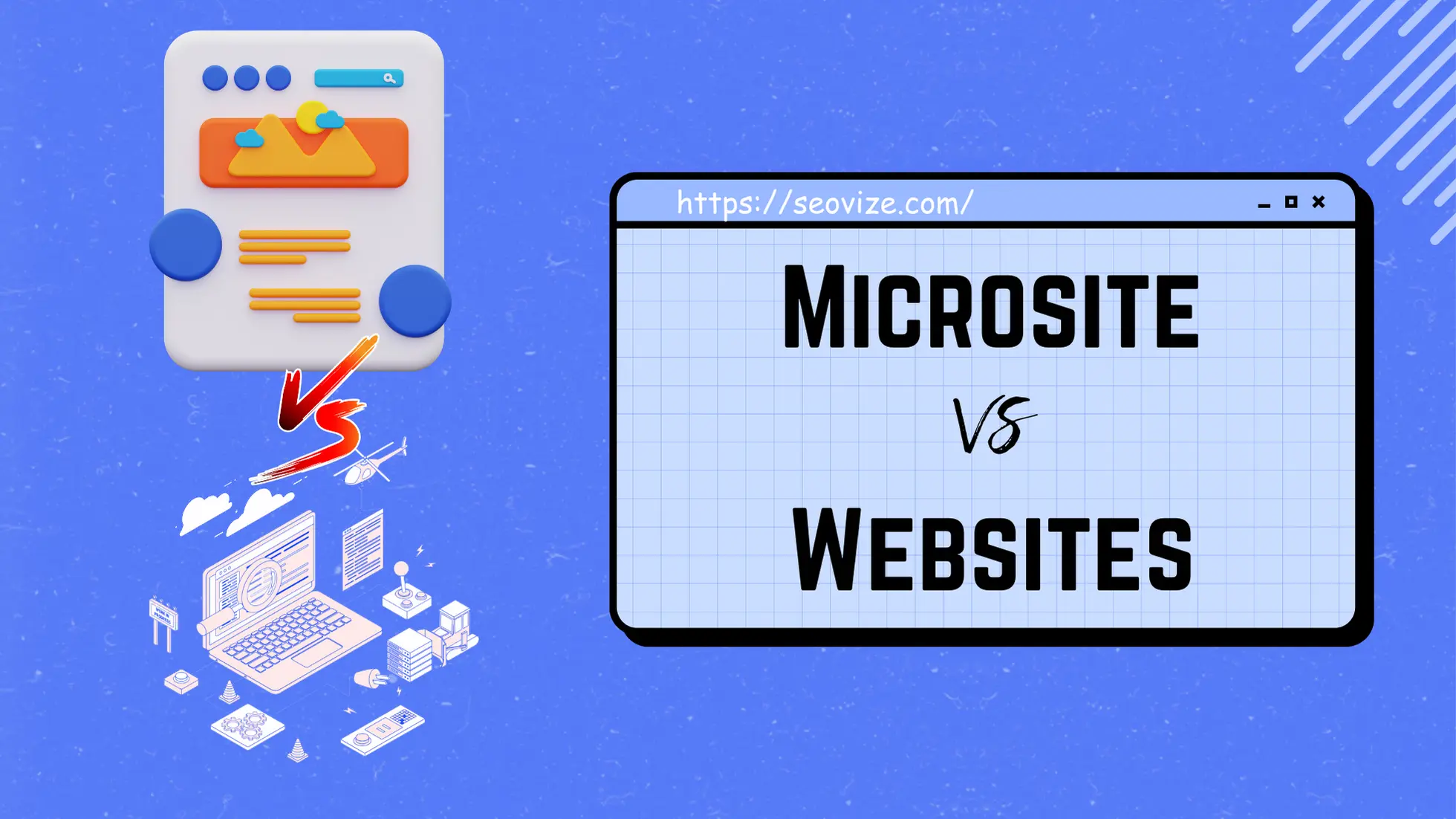
Microsite vs Website? For those just starting in the digital marketing world, it can be hard to keep track of all the different online terms and strategies available.
One common confusion that many people face is the difference between a microsite and a website.
While they may seem similar at first glance, these two terms are quite different, and each has its distinct benefits and drawbacks.
In this blog post, we’ll explore what exactly a microsite and website are, and when you should use each one for your business or project.
Key Takeaways | Microsite vs Website
Here is a quick overview of for microsites vs websites:
Here’s a comparison table between microsites and websites:
| Feature | Microsites | Websites |
|---|---|---|
| Purpose | Targeted marketing campaign | General Brand Presence |
| Size | Typically 1-5 Pages | Any Number of Pages |
| Design | Highly Customizable | Follow Pre-built Templates or Customizable |
| Responsiveness | Easily Maintains Responsiveness | Responsiveness May be More Complex |
| Content Strategy | Focus on Specific Message | More Content for Brand Awareness |
| Navigation | Simplified Navigation, Often with Single Call to Action | Multiple CTAs and Navigation Links |
| SEO | Specific Page Optimization | Wider SEO Strategy |
| Development Time | Quickly, Often Built Using Platform Tools | Longer, Custom Code or CMS Installations |
What Is A Microsite?
A microsite is a small website with a unique URL, devoted to a specific product or campaign. It can be either an independent website or a subsection of a larger website.
Typically, a microsite will focus on one particular topic rather than the full breadth of products and services offered by the parent company.

For example, many companies use microsites to advertise a new product, host an online event, or give customers more information about a particular service.
This helps the company create separate landing pages for each project and allows them to customize the content to fit their specific needs.
What Is A Website?
A website is an all-encompassing digital platform that provides visitors with an overview of the company, its products and services, and other relevant information.
This can include things like a home page, contact page, product page, and blog section.

For instance, a website might be used to showcase a business’s range of products and services, provide customers with tutorials on how to use them effectively and provide additional resources like FAQs.
Websites also typically contain links to other pages within the website, as well as external sites such as social media profiles.
Microsites vs Websites
1. Size and scope
Websites are typically larger and more complex than microsites. They tend to focus on a broader range of topics, while microsites are generally much smaller in size and scope.
Websites are usually much larger than microsites and encompass a wider range of topics. This can involve multiple pages, sections, and informational content that covers a variety of subject areas.
On the other hand, microsites tend to be much more concise with their content and focus on one particular topic, such as a product launch or promotional campaign.
2. Content focus
Microsites are often used for campaigns or promotions, so the content is usually tailored around that particular topic.
Websites, on the other hand, are often more general and can include information about the company’s products and services, tutorials, FAQs, and more.
Microsites can be tailored to a wide range of topics, from product launches and promotional campaigns to seasonal events and charitable causes.
These sites often have their domain names and are hosted separately from the company’s main site, giving them great flexibility in terms of look, feel, and content.
They typically feature high-quality visuals, videos, and other engaging content that is designed to draw attention and encourage users to take action.
3. Target audience
Websites typically serve as the home base for a company and provide an overview of its services and products.
On the contrary, microsites are often used to target specific audiences with content that is tailored to them.
For example, an online travel agency might use a microsite to advertise its vacation packages to parents or seniors.
So while websites provide a comprehensive look at the company’s offerings and brand identity, microsites are often created to focus on one particular product or promotion and attract a more niche audience.
4. Purpose and Objectives
The primary purpose of a website is to give visitors an overview of the company’s services and products. It should provide all the necessary information about the company and make it easy for users to find what they are looking for.
However, microsites are often created with specific goals in mind, such as generating leads or increasing sales.
By targeting a more niche audience, these sites can be used to capture user data, build brand awareness, and increase conversions. They can also be used to promote special offers or highlight new products and services.
Are Microsites and Landing Pages the Same?
No, microsites and landing pages are not the same. Landing pages are often used in conjunction with microsites, but they have their own distinct purpose and objectives.
Microsites vs Landing Pages
Landing pages are single-page websites that focus on a particular product or promotion. They generally do not contain any links to other sites and are designed to capture user data such as email addresses or phone numbers.
On the other hand, microsites can be thought of as smaller websites that focus on a specific topic or product. They often contain multiple pages and links to other sites, such as social media accounts or other related websites.
Microsites are designed to provide detailed information about a particular topic and often include multimedia content like videos, images, or interactive elements.
The main difference between microsites and landing pages is the purpose they serve — microsites generally provide more detailed information about a topic or brand than landing pages.
Moreover, landing pages are focused on capturing user data whereas microsites are focused on providing in-depth information regarding a brand or product.
Advantages and Disadvantages of A Microsite
Advantages of A Microsite
- 1. Targeted Messaging: Microsites allow businesses to focus on a specific topic or audience, providing targeted and relevant content for visitors. This targeted approach can result in higher engagement and conversion rates.
- 2. Creative Freedom: Microsites offer the opportunity for unique designs and layouts that may not fit within the main website’s design template. This allows for a more personalized user experience and greater creative expression.
- 3. Fast Launch: A microsite is typically easier and faster to create than a full website, allowing businesses to react quickly to market changes or capitalize on time-sensitive opportunities.
- 4. Separate Analytics: Microsites have their web analytics, making it easier to measure the success of specific campaigns without getting mixed up with the main website’s data.
Disadvantages of A Microsite
- 1. Higher Maintenance: With multiple websites to manage, more time and resources may be required to maintain overall online initiatives.
- 2. Search Engine Optimization (SEO): As microsites have their own domain, they will need separate SEO efforts to rank higher in search engine results than if the content were added to the main website.
- 3. Brand Consistency: Maintaining consistency across multiple content platforms, including microsites, can be challenging, potentially leading to confusion or dilution of the brand message.
When to use a Microsite?
Considering the advantages and disadvantages, a microsite can be beneficial in the following scenarios:
- Launching a new product or service
- Targeting a specific audience segment
- Running a short-term marketing campaign
- Testing a new market or idea
Creating and Publishing Microsites
Creating and publishing microsites is easy, especially with the help of website platforms like Squarespace or Wix.
These platforms provide templates, drag-and-drop design features, and hosting options to quickly launch a microsite.
Additionally, there are third-party services that specialize in microsites such as Instapage or Carrd, allowing businesses to get started without the need for technical expertise.
Conclusion
In conclusion, understanding the differences in microsites vs websites is important when planning your digital marketing strategy.
While websites are great for providing comprehensive information about your business, microsites are a more targeted and focused option that is especially useful for specific campaigns or products.
By carefully considering your goals and resources, you can choose the digital tool that best suits your needs and helps you reach your target audience with maximum impact.

